Hiram M. Chittenden Locks on:
[Wikipedia]
[Google]
[Amazon]
The Hiram M. Chittenden Locks, or Ballard Locks, is a complex of
 As early as 1854, there was discussion of building a navigable connection between Lake Washington and Puget Sound for the purpose of transporting logs, milled lumber, and fishing vessels. Thirteen years later, the
As early as 1854, there was discussion of building a navigable connection between Lake Washington and Puget Sound for the purpose of transporting logs, milled lumber, and fishing vessels. Thirteen years later, the
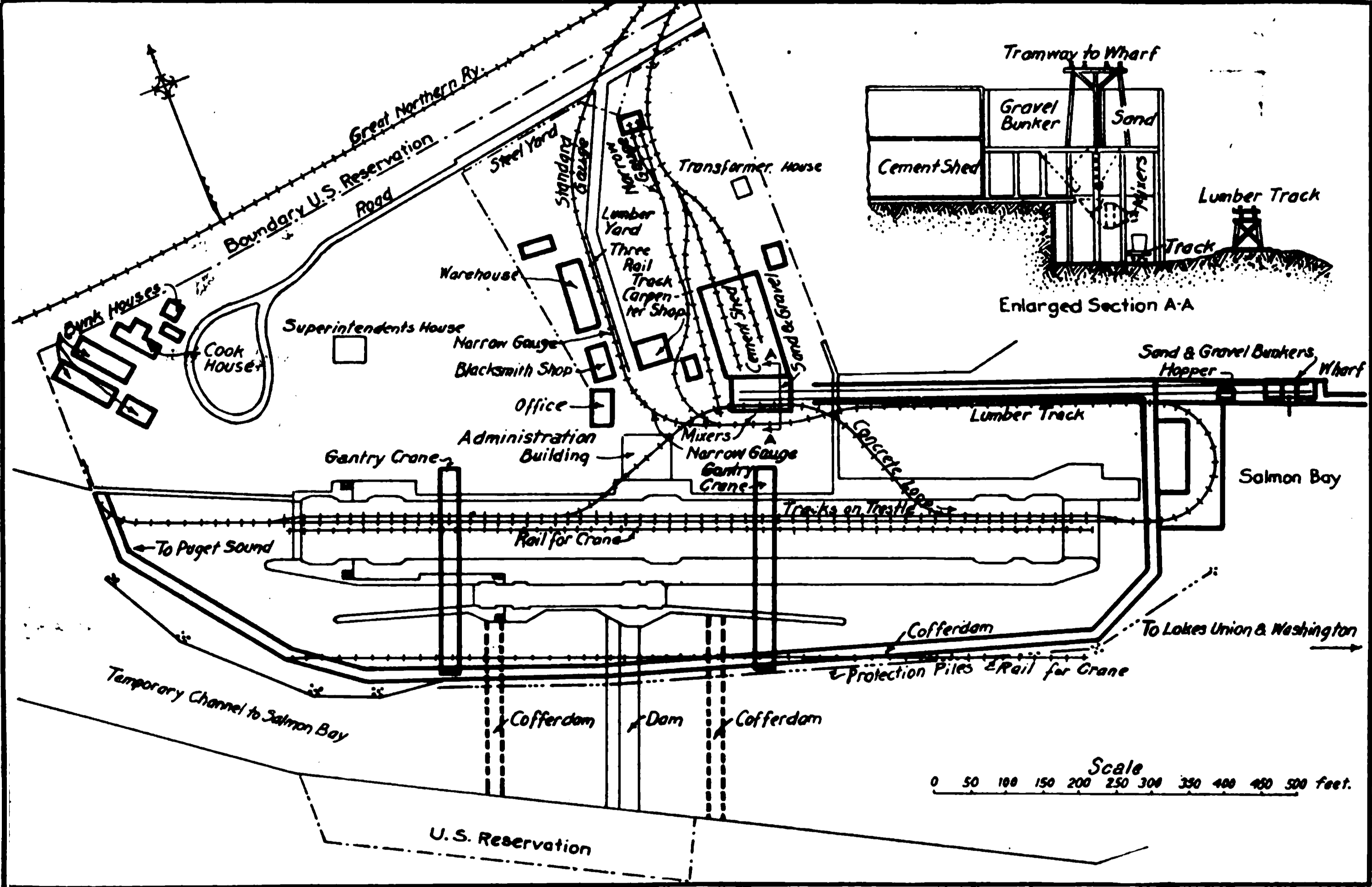 In early 1909, the
In early 1909, the
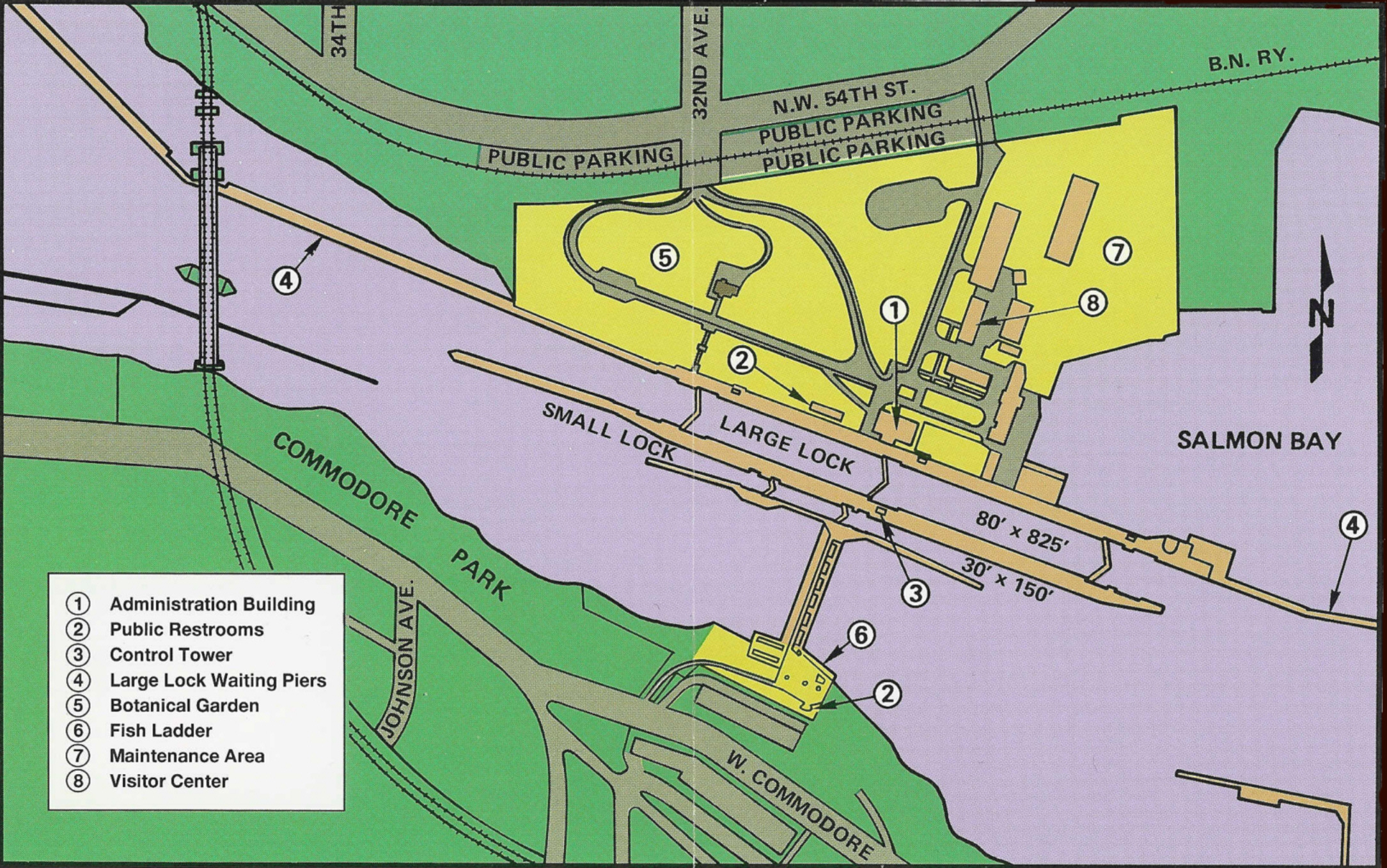 The locks and associated facilities serve three purposes:
* To maintain the water level of the fresh water Lake Washington and Lake Union at above
The locks and associated facilities serve three purposes:
* To maintain the water level of the fresh water Lake Washington and Lake Union at above  The grounds feature a visitors center, as well as the Carl S. English Jr. Botanical Gardens.
Operated by the
The grounds feature a visitors center, as well as the Carl S. English Jr. Botanical Gardens.
Operated by the
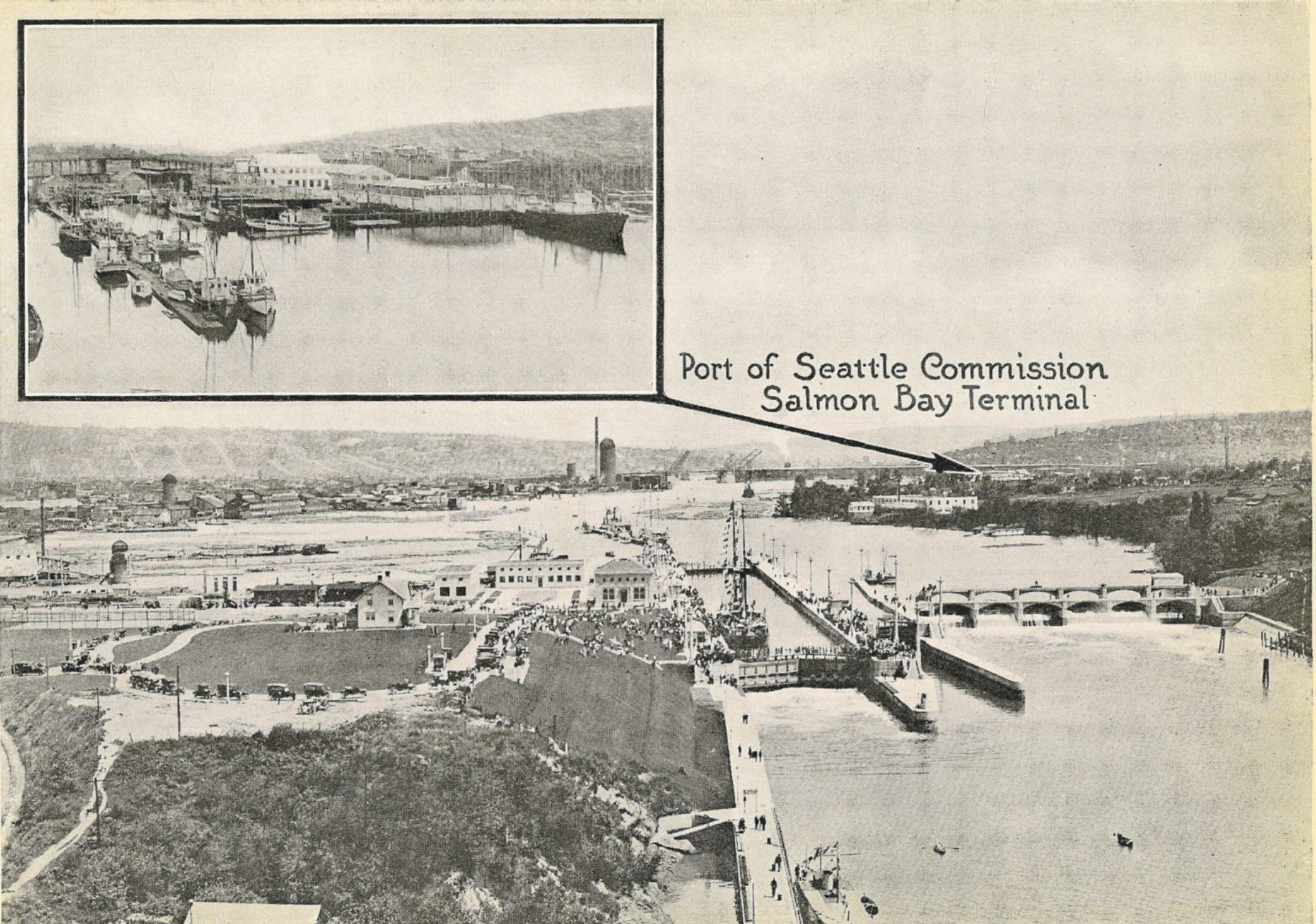 The complex includes two locks. Using the small lock when boat traffic is low conserves fresh water during summer, when the lakes receive less inflow. Having two locks also allows one of the locks to be drained for maintenance without blocking all boat traffic. The large lock is drained for approximately 2-weeks, usually in November, and the small lock is drained for about the same period, usually in March.
The complex includes two locks. Using the small lock when boat traffic is low conserves fresh water during summer, when the lakes receive less inflow. Having two locks also allows one of the locks to be drained for maintenance without blocking all boat traffic. The large lock is drained for approximately 2-weeks, usually in November, and the small lock is drained for about the same period, usually in March.
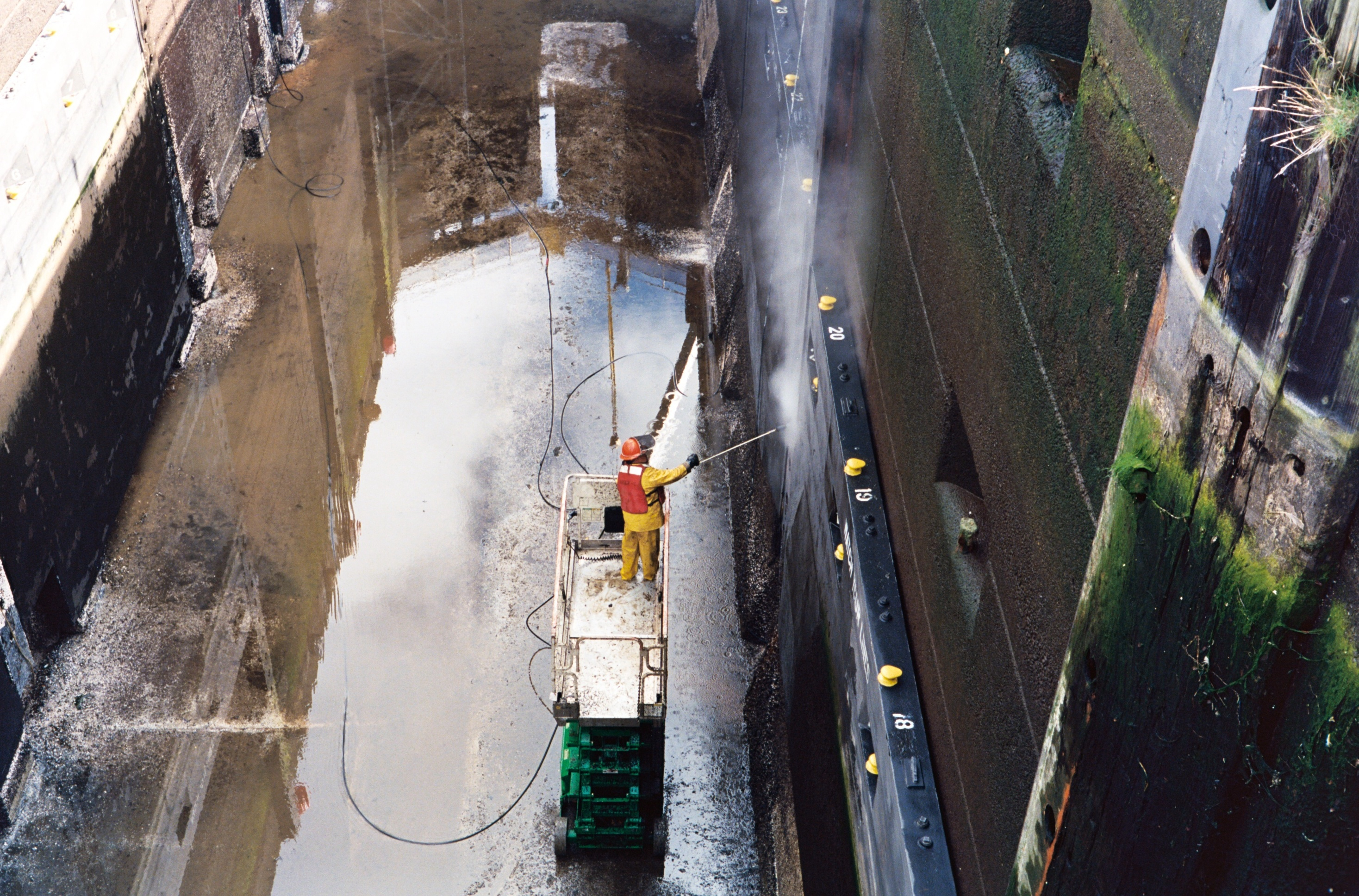 The locks can elevate a vessel , from the level of Puget Sound at a very low tide to the level of freshwater Salmon Bay, in 10–15 minutes. The locks handle both pleasure boats and commercial vessels, ranging from
The locks can elevate a vessel , from the level of Puget Sound at a very low tide to the level of freshwater Salmon Bay, in 10–15 minutes. The locks handle both pleasure boats and commercial vessels, ranging from
File:NWS0002.jpg, Dedication on July 4, 1917
File:Hiram M. Chittenden Locks-3.JPG, Boat and barge in the large lock
File:Hiram M. Chittenden Locks-7.jpg, Control tower
File:Hiram M. Chittenden Locks-2.JPG, Boat entering the small lock
File:Chittenden Locks - sailboat tying off.jpg, Tying off at the small lock
 South of the small lock is a spillway dam with
South of the small lock is a spillway dam with 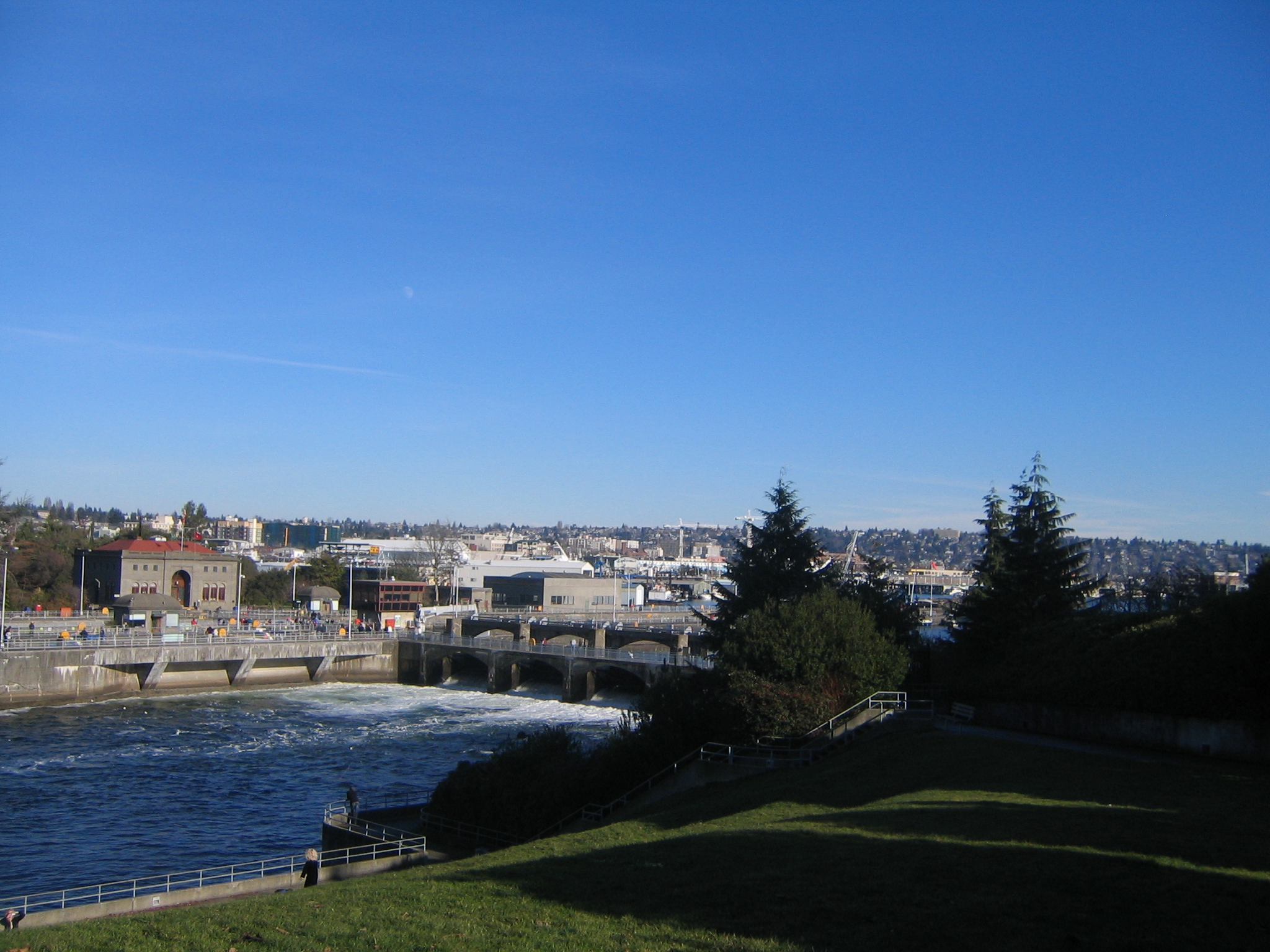 "Smolt flumes" in the spillway help young salmon to pass safely downstream. Higher water levels are maintained in the summer to accommodate recreation as well as to allow the lakes to act as a water storage basin in anticipation of
"Smolt flumes" in the spillway help young salmon to pass safely downstream. Higher water levels are maintained in the summer to accommodate recreation as well as to allow the lakes to act as a water storage basin in anticipation of
 If excessive salt water were allowed to migrate into Salmon Bay, the salt could eventually damage the
If excessive salt water were allowed to migrate into Salmon Bay, the salt could eventually damage the


 The fish ladder at the Chittenden locks is unusual—materials published by the federal government say "unique"—in being located where salt and fresh water meet. Normally, fish ladders are located entirely within fresh water.
Pacific salmon are ''anadromous''; they hatch in lakes, rivers, and streams—or, nowadays
The fish ladder at the Chittenden locks is unusual—materials published by the federal government say "unique"—in being located where salt and fresh water meet. Normally, fish ladders are located entirely within fresh water.
Pacific salmon are ''anadromous''; they hatch in lakes, rivers, and streams—or, nowadays 
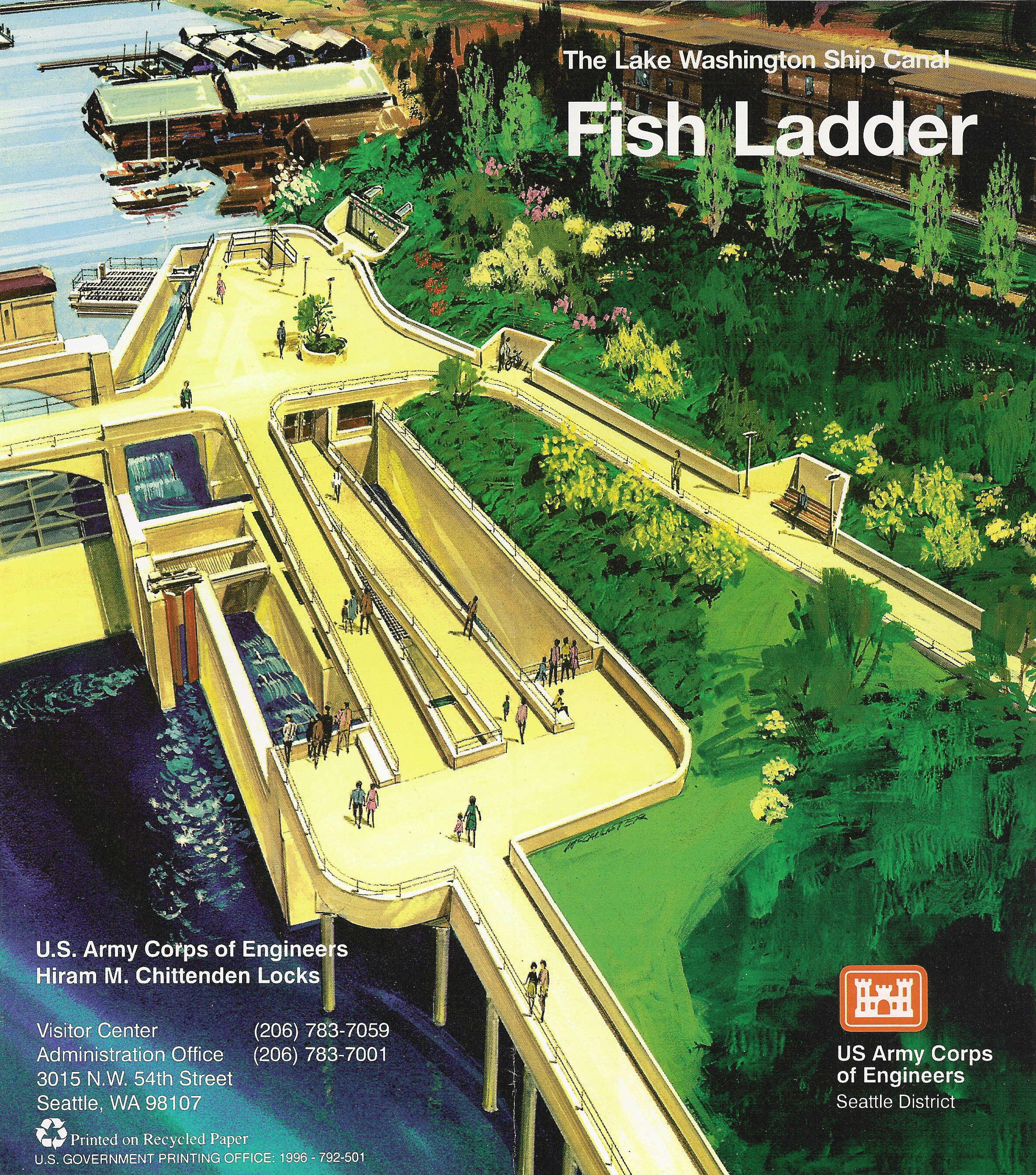
US Army Corps of Engineers, Seattle District: Lake Washington Ship Canal and Hiram M. Chittenden Locks
* *Corps of Engineers Foundation http://www.ballardlocks.org {{Coord, 47, 39, 55.68, N, 122, 23, 49.56, W, type:landmark_scale:2000, display=title 1917 establishments in Washington (state) Ballard, Seattle Dams on the National Register of Historic Places in Washington (state) Historic Civil Engineering Landmarks Locks on the National Register of Historic Places in Washington (state) National Register of Historic Places in Seattle Transport infrastructure completed in 1916 Transportation buildings and structures in Seattle Transportation buildings and structures on the National Register of Historic Places in Washington (state) United States Army Corps of Engineers Water transport in Seattle
lock
Lock(s) may refer to:
Common meanings
*Lock and key, a mechanical device used to secure items of importance
*Lock (water navigation), a device for boats to transit between different levels of water, as in a canal
Arts and entertainment
* ''Lock ...
s at the west end of Salmon Bay
Salmon Bay is a portion of the Lake Washington Ship Canal, which passes through the city of Seattle, linking Lake Washington to Puget Sound, lying west of the Fremont Cut. It is the westernmost section of the canal and empties into Puget Sound' ...
in Seattle
Seattle ( ) is a seaport city on the West Coast of the United States. It is the seat of King County, Washington. With a 2020 population of 737,015, it is the largest city in both the state of Washington and the Pacific Northwest regio ...
, Washington
Washington commonly refers to:
* Washington (state), United States
* Washington, D.C., the capital of the United States
** A metonym for the federal government of the United States
** Washington metropolitan area, the metropolitan area centered on ...
's Lake Washington Ship Canal
The Lake Washington Ship Canal, which runs through the city of Seattle, connects the fresh water body of Lake Washington with the salt water inland sea of Puget Sound. The Hiram M. Chittenden Locks accommodate the approximately difference in w ...
, between the neighborhoods of Ballard to the north and Magnolia
''Magnolia'' is a large genus of about 210 to 340The number of species in the genus ''Magnolia'' depends on the taxonomic view that one takes up. Recent molecular and morphological research shows that former genera ''Talauma'', ''Dugandiodendro ...
to the south.
The Ballard Locks carry more boat traffic than any other lock in the U.S., and the locks, along with the fish ladder and the surrounding Carl S. English Jr. Botanical Gardens, attract more than one million visitors annually, making it one of Seattle's top tourist attractions. The construction of the locks profoundly reshaped the topography of Seattle and the surrounding area, lowering the water level of Lake Washington and Lake Union
Lake Union is a freshwater lake located entirely within the city limits of Seattle, Washington, United States. It is a major part of the Lake Washington Ship Canal, which carries fresh water from the much larger Lake Washington on the east to ...
by , adding miles of new waterfront land, reversing the flow of rivers, and leaving piers in the eastern half of Salmon Bay
Salmon Bay is a portion of the Lake Washington Ship Canal, which passes through the city of Seattle, linking Lake Washington to Puget Sound, lying west of the Fremont Cut. It is the westernmost section of the canal and empties into Puget Sound' ...
high and dry. The Locks are listed on the National Register of Historic Places
The National Register of Historic Places (NRHP) is the United States federal government's official list of districts, sites, buildings, structures and objects deemed worthy of preservation for their historical significance or "great artistic v ...
and have been designated by the American Society of Civil Engineers
American(s) may refer to:
* American, something of, from, or related to the United States of America, commonly known as the "United States" or "America"
** Americans, citizens and nationals of the United States of America
** American ancestry, pe ...
as a National Historic Civil Engineering Landmark
__NOTOC__
The following is a list of Historic Civil Engineering Landmarks as designated by the American Society of Civil Engineers since it began the program in 1964. The designation is granted to projects, structures, and sites in the United State ...
.
Prior to construction
 As early as 1854, there was discussion of building a navigable connection between Lake Washington and Puget Sound for the purpose of transporting logs, milled lumber, and fishing vessels. Thirteen years later, the
As early as 1854, there was discussion of building a navigable connection between Lake Washington and Puget Sound for the purpose of transporting logs, milled lumber, and fishing vessels. Thirteen years later, the United States Navy
The United States Navy (USN) is the maritime service branch of the United States Armed Forces and one of the eight uniformed services of the United States. It is the largest and most powerful navy in the world, with the estimated tonnage ...
endorsed a canal project, which included a plan for building a naval shipyard on Lake Washington. In 1891 the U.S. Army Corps of Engineers
, colors =
, anniversaries = 16 June (Organization Day)
, battles =
, battles_label = Wars
, website =
, commander1 = ...
started planning the project. Some preliminary work was begun in 1906, and work began in earnest five years later under the command of Hiram M. Chittenden
Hiram Martin Chittenden (October 25, 1858 – October 9, 1917) was an American engineer and historian. A graduate of West Point, he was the Seattle district engineer for the Army Corps of Engineers from 1906 to 1908). Chittenden was one of ...
. The delays in canal planning and construction resulted in the US Navy building the Puget Sound Naval Shipyard
Puget Sound Naval Shipyard, officially Puget Sound Naval Shipyard and Intermediate Maintenance Facility (PSNS & IMF), is a United States Navy shipyard covering 179 acres (0.7 km2) on Puget Sound at Bremerton, Washington in uninterrupted u ...
in Bremerton, Washington
Bremerton is a city in Kitsap County, Washington. The population was 37,729 at the 2010 census and an estimated 41,405 in 2019, making it the largest city on the Kitsap Peninsula. Bremerton is home to Puget Sound Naval Shipyard and the Bremerto ...
, which is located across the Sound from Seattle.
Construction
 In early 1909, the
In early 1909, the Washington State Legislature
The Washington State Legislature is the state legislature of the U.S. state of Washington. It is a bicameral body, composed of the lower Washington House of Representatives, composed of 98 Representatives, and the upper Washington State Senat ...
appropriated $250,000, placed under the control of the Corps of Engineers, for excavation of the canal between Lake Union and Lake Washington. In June 1910, the US Congress gave its approval for the lock, on the condition that the rest of the canals along the route be paid for locally. Construction was then delayed by legal challenges, mainly by mill owners in Ballard who feared property damage and loss of waterfront in Salmon Bay, and by Lake Washington property owners.
Under Major James. B. Cavanaugh, Chittenden's replacement as Seattle District Commander, construction of the Ballard, or Government, Locks connecting Salmon Bay to Shilshole Bay began in 1911, proceeding without further controversy or legal entanglements. In July 1912, the Locks gates were closed for the first time, turning Salmon Bay from saltwater to freshwater. The first ship passed through the locks on August 3, 1916. On August 25, 1916, the temporary dam at Montlake was breached. During the following three months, Lake Washington drained, lowering the water level by and drying up more than of wetland
A wetland is a distinct ecosystem that is flooded or saturated by water, either permanently (for years or decades) or seasonally (for weeks or months). Flooding results in oxygen-free (anoxic) processes prevailing, especially in the soils. The ...
s, as well as drying up the Black River and cutting off the Cedar River salmon run.
The Cedar River was rerouted into Lake Washington to provide sufficient water flow for operating the Locks. Additionally the White River was rerouted into the Puyallup River. The Cedar and White Rivers both originally flowed into the Duwamish causing frequent flooding. The rerouting of the rivers opened up huge lowland areas for development but significantly disrupted the Duwamish salmon runs. To rectify this problem, salmon runs were reintroduced to migrate through the locks. The locks officially opened for boat traffic on May 8, 1917. The total cost of the project to that point was $3.5 million, with $2.5 million having come from the federal government and the rest from local governments.
To allow for the intended boat traffic, three bridges were removed along the ship canal route, at Latona Avenue, Fremont, Stone Way. The Ballard and Fremont Bridge Fremont Bridge may refer to:
* Fremont Bridge (Portland, Oregon)
* Fremont Bridge (Seattle)
The Fremont Bridge is a double-leaf bascule bridge that spans the Fremont Cut in Seattle, Washington. The bridge, which connects Fremont Avenue North and ...
s were completed in 1917, followed by the University Bridge in 1919, and Montlake Bridge
The Montlake Bridge is a double-leaf bascule bridge that carries State Route 513 (Montlake Boulevard) over Seattle's Montlake Cut—part of the Lake Washington Ship Canal—connecting Montlake and the University District.
It is the easternmo ...
in 1925. The University Bridge was improved in 1932, and in 1934 the Lake Washington Ship Canal project was declared complete.
While generally a success, the project was not without its problems. Salt water began to make its way upstream toward Lake Union, requiring a system of siphons and flushing mechanisms. Because the Cedar River was the main water source both for the lakes and locks and for Seattle's potable water, at times there were problems maintaining an adequate water supply to maintain lake level and operate the locks. Conversely, with several rivers redirected, flooding worsened throughout the watershed. That last problem was exacerbated by logging, and at times during storms the locks had to be opened just to allow water to flow out.
Function
 The locks and associated facilities serve three purposes:
* To maintain the water level of the fresh water Lake Washington and Lake Union at above
The locks and associated facilities serve three purposes:
* To maintain the water level of the fresh water Lake Washington and Lake Union at above sea level
Mean sea level (MSL, often shortened to sea level) is an average surface level of one or more among Earth's coastal bodies of water from which heights such as elevation may be measured. The global MSL is a type of vertical datuma standardised g ...
, or more specifically, above Puget Sound's mean low tide
Tides are the rise and fall of sea levels caused by the combined effects of the gravity, gravitational forces exerted by the Moon (and to a much lesser extent, the Sun) and are also caused by the Earth and Moon orbiting one another.
Tide t ...
.
* To prevent the mixing of sea water
Seawater, or salt water, is water from a sea or ocean. On average, seawater in the world's oceans has a salinity of about 3.5% (35 g/L, 35 ppt, 600 mM). This means that every kilogram (roughly one liter by volume) of seawater has approx ...
from Puget Sound with the fresh water of the lakes (saltwater intrusion
Saltwater intrusion is the movement of saline water into freshwater aquifers, which can lead to groundwater quality degradation, including drinking water sources, and other consequences. Saltwater intrusion can naturally occur in coastal aquifers ...
).
* To move boats from the water level of the lakes to the water level of Puget Sound, and vice versa.
The complex includes two locks, (small) and (large). The complex also includes a spillway
A spillway is a structure used to provide the controlled release of water downstream from a dam or levee, typically into the riverbed of the dammed river itself. In the United Kingdom, they may be known as overflow channels. Spillways ensure tha ...
with six gates to assist in water-level control. A fish ladder
A fish ladder, also known as a fishway, fish pass, fish steps, or fish cannon is a structure on or around artificial and natural barriers (such as dams, locks and waterfalls) to facilitate diadromous fishes' natural migration as well as movemen ...
is integrated into the locks for migration of anadromous
Fish migration is mass relocation by fish from one area or body of water to another. Many types of fish migrate on a regular basis, on time scales ranging from daily to annually or longer, and over distances ranging from a few metres to thousan ...
fish, notably salmon
Salmon () is the common name for several list of commercially important fish species, commercially important species of euryhaline ray-finned fish from the family (biology), family Salmonidae, which are native to tributary, tributaries of the ...
.
 The grounds feature a visitors center, as well as the Carl S. English Jr. Botanical Gardens.
Operated by the
The grounds feature a visitors center, as well as the Carl S. English Jr. Botanical Gardens.
Operated by the US Army Corps of Engineers
, colors =
, anniversaries = 16 June (Organization Day)
, battles =
, battles_label = Wars
, website =
, commander1 = ...
, the locks were formally opened on July 4, 1917, although the first ship passed on August 3, 1916. They were named after US Army
The United States Army (USA) is the land service branch of the United States Armed Forces. It is one of the eight U.S. uniformed services, and is designated as the Army of the United States in the U.S. Constitution.Article II, section 2, cla ...
Major Hiram M. Chittenden, the Seattle District Engineer for the Corps of Engineers from April 1906 to September 1908. They were added to the National Register of Historic Places in 1978.
Vessels passing from the freshwater Lakes Washington and Union to Puget Sound enter the lock chamber through the open upper gates (A in the accompanying diagram). The lower gates (B) and the draining valve (D) are closed. The vessel is assisted by the lockwall attendants who assure it is tied down and ready for the chamber to be drained.
Next, the upper gates (A) and the filling valve (C) are closed and the draining valve (D) is opened allowing water to drain via gravity out to Puget Sound.
When the water pressure is equal on both sides of the gate, the lower gates (B) are opened, allowing the vessels to leave the lock chamber.
The process is reversed for upstream locking.
Locks
 The complex includes two locks. Using the small lock when boat traffic is low conserves fresh water during summer, when the lakes receive less inflow. Having two locks also allows one of the locks to be drained for maintenance without blocking all boat traffic. The large lock is drained for approximately 2-weeks, usually in November, and the small lock is drained for about the same period, usually in March.
The complex includes two locks. Using the small lock when boat traffic is low conserves fresh water during summer, when the lakes receive less inflow. Having two locks also allows one of the locks to be drained for maintenance without blocking all boat traffic. The large lock is drained for approximately 2-weeks, usually in November, and the small lock is drained for about the same period, usually in March.
 The locks can elevate a vessel , from the level of Puget Sound at a very low tide to the level of freshwater Salmon Bay, in 10–15 minutes. The locks handle both pleasure boats and commercial vessels, ranging from
The locks can elevate a vessel , from the level of Puget Sound at a very low tide to the level of freshwater Salmon Bay, in 10–15 minutes. The locks handle both pleasure boats and commercial vessels, ranging from kayak
A kayak is a small, narrow watercraft which is typically propelled by means of a double-bladed paddle. The word kayak originates from the Greenlandic word ''qajaq'' ().
The traditional kayak has a covered deck and one or more cockpits, each se ...
s to fishing boats returning from the Bering Sea
The Bering Sea (, ; rus, Бе́рингово мо́ре, r=Béringovo móre) is a marginal sea of the Northern Pacific Ocean. It forms, along with the Bering Strait, the divide between the two largest landmasses on Earth: Eurasia and The Ameri ...
to cargo ships. Over 1 million tons of cargo, fuel, building materials, and seafood products pass through the locks each year.
Spillway
 South of the small lock is a spillway dam with
South of the small lock is a spillway dam with tainter gate
The Tainter gate is a type of radial arm floodgate used in dams and canal locks to control water flow. It is named for Wisconsin structural engineer Jeremiah Burnham Tainter.
A side view of a Tainter gate resembles a slice of pie with the c ...
s used to regulate the freshwater levels of the ship canal and lakes. The gates on the dam release or store water to maintain the lake within a range of above sea level. Maintaining this lake level is necessary for floating bridges, mooring facilities, and vessel clearances under bridges.
 "Smolt flumes" in the spillway help young salmon to pass safely downstream. Higher water levels are maintained in the summer to accommodate recreation as well as to allow the lakes to act as a water storage basin in anticipation of
"Smolt flumes" in the spillway help young salmon to pass safely downstream. Higher water levels are maintained in the summer to accommodate recreation as well as to allow the lakes to act as a water storage basin in anticipation of drought
A drought is defined as drier than normal conditions.Douville, H., K. Raghavan, J. Renwick, R.P. Allan, P.A. Arias, M. Barlow, R. Cerezo-Mota, A. Cherchi, T.Y. Gan, J. Gergis, D. Jiang, A. Khan, W. Pokam Mba, D. Rosenfeld, J. Tierney, an ...
conditions.
Salt water barrier
freshwater ecosystem
Freshwater ecosystems are a subset of Earth's aquatic ecosystems. They include lakes, ponds, rivers, streams, springs, bogs, and wetlands. They can be contrasted with marine ecosystems, which have a larger salt content. Freshwater habitats can be ...
. To prevent this, a basin was dredged just above (east of) the large lock. The heavier salt water settles into the basin and drains through a pipe discharging downstream of the locks area. In 1975, the saltwater drain was modified to divert some salt water from the basin to the fish ladder, where it is added via a diffuser to the fish ladder attraction water; see below
Below may refer to:
*Earth
*Ground (disambiguation)
*Soil
*Floor
*Bottom (disambiguation)
Bottom may refer to:
Anatomy and sex
* Bottom (BDSM), the partner in a BDSM who takes the passive, receiving, or obedient role, to that of the top or ...
.
To further restrict saltwater intrusion, in 1966, a hinged barrier was installed just upstream of the large lock. This hollow metal barrier is filled with air to remain in the upright position, blocking the heavier salt water. When necessary to accommodate deep-draft vessels, the barrier is flooded and sinks to the bottom of the chamber.
Fish ladder


 The fish ladder at the Chittenden locks is unusual—materials published by the federal government say "unique"—in being located where salt and fresh water meet. Normally, fish ladders are located entirely within fresh water.
Pacific salmon are ''anadromous''; they hatch in lakes, rivers, and streams—or, nowadays
The fish ladder at the Chittenden locks is unusual—materials published by the federal government say "unique"—in being located where salt and fresh water meet. Normally, fish ladders are located entirely within fresh water.
Pacific salmon are ''anadromous''; they hatch in lakes, rivers, and streams—or, nowadays fish hatcheries
A fish hatchery is a place for artificial breeding, hatching, and rearing through the early life stages of animals—finfish and shellfish in particular.Crespi V., Coche A. (2008) Food and Agriculture Organization of the United Nations (FAO) Gloss ...
—migrate to sea, and only at the end of their life return to fresh water to spawn. Prior to the Locks construction, no significant salmon runs existed here, as there was only a small drainage stream from Lake Union into Salmon Bay. In order to provide enough water to operate the Locks, Cedar River was rerouted into Lake Washington (which was lowered 9 feet). Cedar River originally flowed into the Duwamish River along with the White River from the South. White River was rerouted into the Puyallup River. Cedar and White Rivers did support significant Salmon runs but also created severe flooding conditions for the early settlers. The rerouting of these two major rivers was a mixed blessing, while reducing flood threats, the Duwamish River salmon runs were decimated. To rectify this situation, salmon runs were rerouted through the Locks, which included introducing a major run of Sockeye Salmon using stock from Baker River, Washington.
The ladder was designed to use attraction water: fresh water flowing swiftly out the bottom of the fish ladder, in the direction opposite which anadromous fish migrate at the end of their lives. However, the attraction water from this first ladder was not effective. Instead, most salmon used the locks. This made them an easy target for predators; also, many were injured by hitting the walls and gates of the locks, or by hitting boat propellers.
The Corps rebuilt the fish ladder in 1976 by increasing the flow of attraction water and adding more weir
A weir or low head dam is a barrier across the width of a river that alters the flow characteristics of water and usually results in a change in the height of the river level. Weirs are also used to control the flow of water for outlets of l ...
s: most weirs are now one foot higher than the previous one. The old fish ladder had only 10 "steps"; the new one has 21. A diffuser well mixes salt water gradually into the last 10 weirs. As a part of the rebuilding, the Corps also added an underground chamber with a viewing gallery.
The fish approaching the ladder smell the attraction water, recognizing the scent of Lake Washington and its tributaries. They enter the ladder, and either jump over each of the 21 weirs or swim though tunnel-like openings. They exit the ladder into the fresh water of Salmon Bay. They continue following the waterway to the lake, river, or stream where they were born. Once there, the females lay eggs, which the males fertilize. Most salmon die shortly after spawning.
The offspring remain in the fresh water until they are ready to migrate to the ocean as smolts. In a few years, the surviving adults return, climb the fish ladder, and reach their spawning ground to continue the life cycle. Of the millions of young fish born, only a relative few survive to adulthood. Causes of death include natural predators, commercial and sport fishing, disease, low stream flows, poor water quality, flooding, and concentrated developments along streams and lakes.
Visitors to the locks can observe the salmon through windows as they progress along their route. Although the viewing area is open year-round, the "peak" viewing time is during spawning season, from about the beginning of July through mid-August. A public art work, commissioned by the Seattle Arts Commission, provides literary interpretation of the experience through recordings of Seattle poet Judith Roche's "Salmon Suite," a sequence of five poems tied to the annual migratory sequence of the fish.

Migratory fish
Among the species of salmonids migrating routinely through the ladder at the Chittenden Locks are Chinook (king) salmon (''Oncorhynchus tshawytscha
The Chinook salmon (''Oncorhynchus tshawytscha'') is the largest and most valuable species of Pacific salmon in North America, as well as the largest in the genus ''Oncorhynchus''. Its common name is derived from the Chinookan peoples. Other ve ...
''), Coho (silver) salmon (''Oncorhynchus kisutch
The coho salmon (''Oncorhynchus kisutch;'' Karuk: achvuun) is a species of anadromous fish in the salmon family and one of the five Pacific salmon species. Coho salmon are also known as silver salmon or "silvers". The scientific species name is ...
''), Sockeye (red) salmon (''Oncorhynchus nerka
The sockeye salmon (''Oncorhynchus nerka''), also called red salmon, kokanee salmon, blueback salmon, or simply sockeye, is an anadromous species of salmon found in the Northern Pacific Ocean and rivers discharging into it. This species is a P ...
''). Sockeye primarily migrate up the Cedar River to spawn and most end up at the Landsberg Dam Hatchery. Chinook and Coho migrate up the Issaquah Creek and most end up at the Issaquah Hatchery.
Steelhead (''Oncorhynchus mykiss
The rainbow trout (''Oncorhynchus mykiss'') is a species of trout native to cold-water tributaries of the Pacific Ocean in Asia and North America. The steelhead (sometimes called "steelhead trout") is an anadromous (sea-run) form of the coastal ...
''), once migrated through the Locks but none have been seen in years. The run is considered functionally extinct.
Notes

External links
US Army Corps of Engineers, Seattle District: Lake Washington Ship Canal and Hiram M. Chittenden Locks
* *Corps of Engineers Foundation http://www.ballardlocks.org {{Coord, 47, 39, 55.68, N, 122, 23, 49.56, W, type:landmark_scale:2000, display=title 1917 establishments in Washington (state) Ballard, Seattle Dams on the National Register of Historic Places in Washington (state) Historic Civil Engineering Landmarks Locks on the National Register of Historic Places in Washington (state) National Register of Historic Places in Seattle Transport infrastructure completed in 1916 Transportation buildings and structures in Seattle Transportation buildings and structures on the National Register of Historic Places in Washington (state) United States Army Corps of Engineers Water transport in Seattle